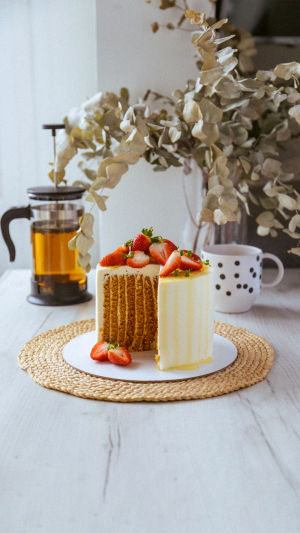Want to know the key ingredients and techniques that make the difference between a good cake and a great one? Keep reading to uncover all the essential tips for baking a delicious cake that will impress everyone.
Baking a cake is about the art and the science for us. It involves combining the right ingredients in precise measurements, understanding the proper techniques, and having the patience to let your creation come together perfectly.
Whether you’re a beginner or an experienced baker, this guide will help you master the basics of cake baking, from selecting ingredients to perfecting your baking technique.
<h3>1. Essential Ingredients for Cake Baking</h3>
The foundation of any great cake starts with the ingredients. Understanding the role each ingredient plays will help you make the right choices for your recipe:
<b>Flour:</b> The type of flour you use will greatly affect the texture of your cake. All-purpose flour is versatile and works well for most cakes, but cake flour has a finer texture and lower protein content, resulting in a lighter, more tender cake. Sift the flour before adding it to your batter to prevent lumps and ensure an even mix.
<b>Sugar:</b> Sugar not only adds sweetness but also helps to tenderize the cake and create a moist texture. Granulated white sugar is standard, but brown sugar can add a deeper, more complex flavour.
<b>Fats:</b> Butter and oil are the most common fats used in cake baking. Butter provides a rich flavour and helps create a light, fluffy texture when creamed with sugar. Oil, on the other hand, keeps cakes moist and tender. Depending on the recipe, you might use one or both.
<b>Leavening Agents:</b> Baking powder and baking soda are leavening agents that help the cake rise. They work by creating bubbles in the batter that expand during baking, giving your cake its light, airy texture. Be sure to measure these ingredients precisely, as even a slight excess or deficiency can significantly impact the final result of your cake.
<b>Eggs:</b> Eggs provide structure and stability to your cake batter, as well as adding moisture and richness. They also act as an emulsifier, helping to blend fats and liquids into a smooth batter. Use eggs at room temperature for the best results.
<h3>2. Mastering Cake Baking Techniques</h3>
Once you have your ingredients, the next step is mastering the techniques that will ensure your cake bakes perfectly:
<b>Measuring Ingredients:</b> In cake baking, it's important that you can measure your ingredients accurately. You use measuring cups for dry ingredients and liquid measuring cups for wet ingredients. You also need to use a ruler to smooth out the dry ingredients so that you can measure them accurately. For best results, consider using a kitchen scale to weigh your ingredients.
<b>Mixing the Batter:</b> The way you mix your cake batter can significantly affect its texture. Overmixing can result in a dense, tough cake, while undermixing can lead to uneven texture and pockets of flour. First, you'll cream the butter and sugar until soft, then add the eggs. Next, you'll add the wet and dry ingredients alternately, beating them until smooth.
<b>Baking and Cooling:</b> Preheat your oven to the temperature specified in your recipe and place the cake pans in the centre of the oven for even baking. You should remember to avoid opening the oven too often as this can cause the cake to sink. You can test the cake for doneness by inserting a toothpick into the cake. If the toothpick comes out clean, the cake is finished and should cool in the pan for 10-15 minutes.
The Best Vanilla Cake Recipe
Video by Buttercut Bakery
Baking the perfect cake is all about understanding your ingredients, mastering essential techniques, and having fun with decoration. With a little practice and patience, you can create a delicious, beautiful cake that’s sure to impress. Whether you’re baking for a special occasion or just to satisfy a sweet craving, these tips will help you achieve the perfect cake every time. Happy baking!





